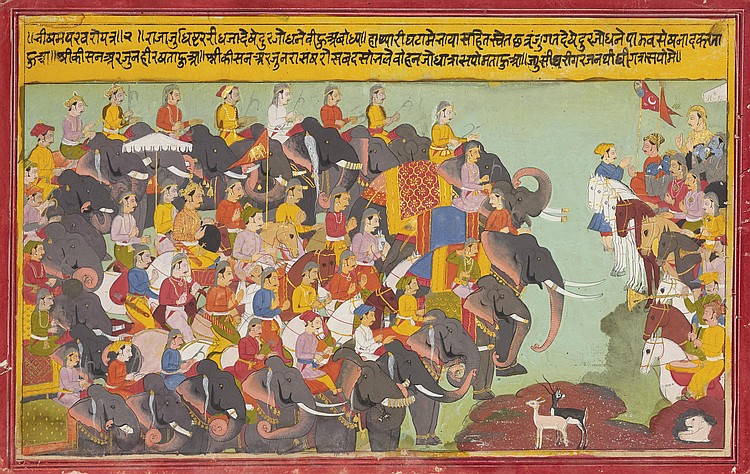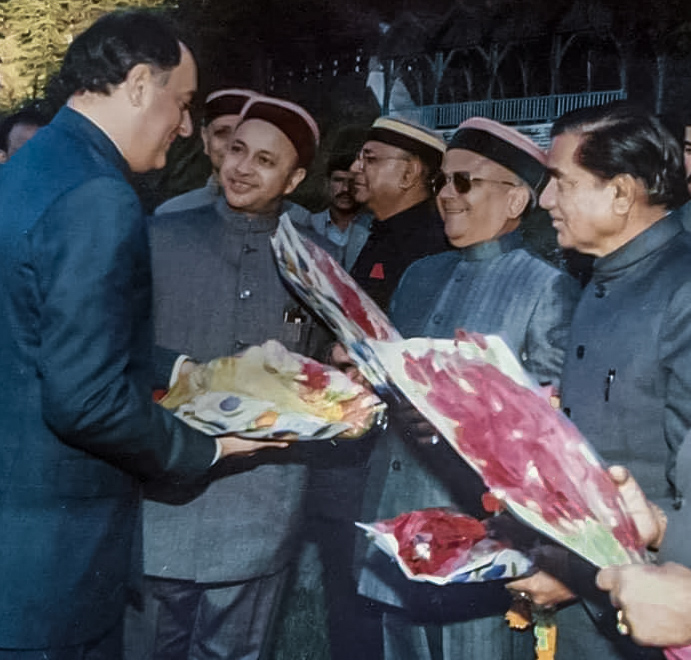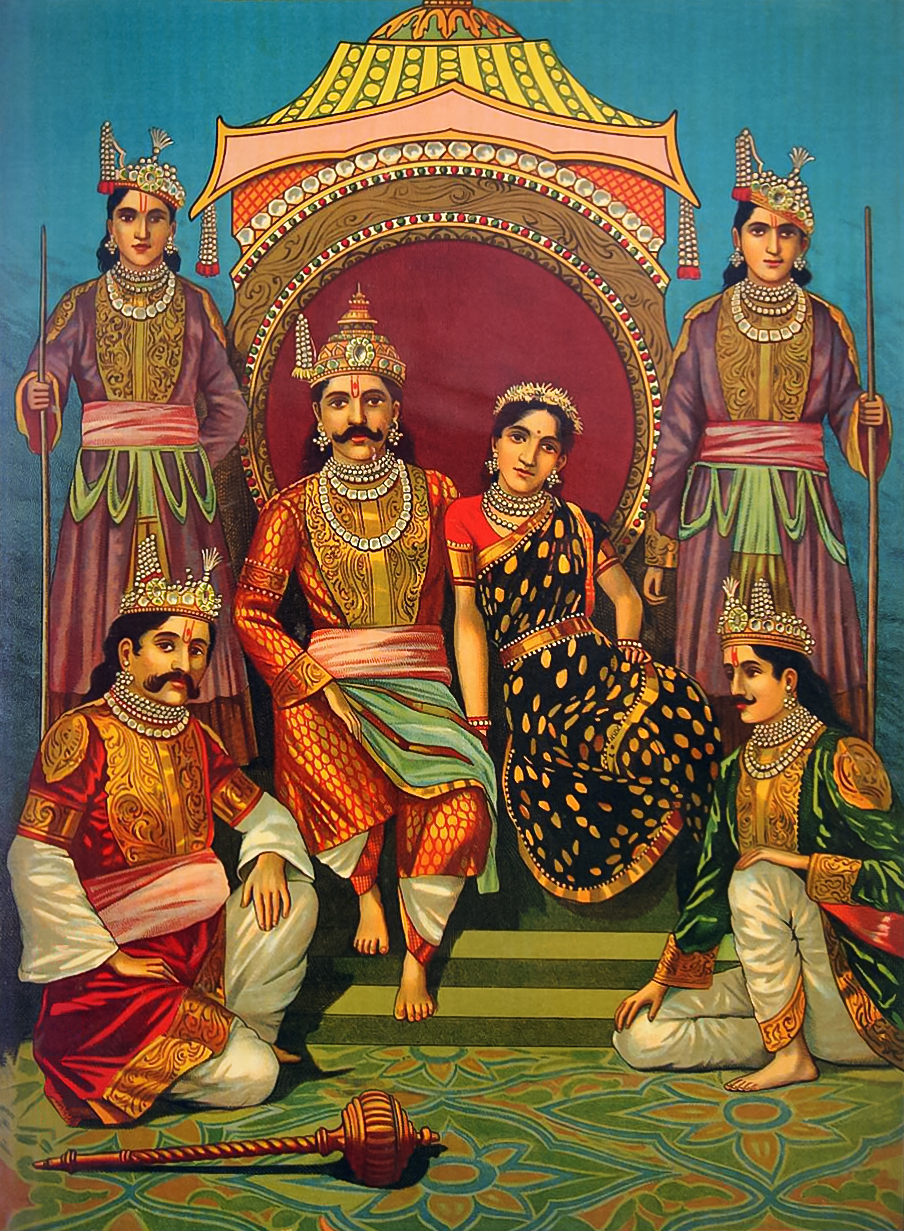|
Thoda (archery)
Thoda is an Indian form of archery found in Himachal Pradesh, with elements of dance and music included. It is generally performed during various local festivals alongside other traditional games, and may be a symbolic representation of the war described in the Mahabharata. The aim of Thoda archery is for two opposing teams to shoot arrows at the legs of the other team (which are wrapped in thick cloth); Thoda competitions take place in Himachal Pradesh annually. History Thoda is a form of martial art, which is a combination of traditional archery, dance, and music, and it is popular among the Khasas of Solan, Shimla, and Sirmour. A folk song from Thoda goes like "Bina Tikke Thakure Majhgaon ra Khoshia Deo Shirgul ri jubri de puja O lohu ra bhukha Khoshia." Literally meaning "I am the Lord Khashia of Majhgaon under no Raja or Thakur (quite independent and obeying no kings), have reached the arena of Shirgul god. I am hungry Khashia of the blood of my opponents. The game of Thoda ... [...More Info...] [...Related Items...] OR: [Wikipedia] [Google] [Baidu] |
Archery
Archery is the sport, practice, or skill of using a Bow and arrow, bow to shooting, shoot arrows.Paterson ''Encyclopaedia of Archery'' p. 17 The word comes from the Latin ''arcus'', meaning bow. Historically, archery has been used for hunting and combat. In modern times, it is mainly a competitive sport and recreational activity. A person who practices archery is typically called an archer, bowman, or toxophilite. History Origins and ancient archery The oldest known evidence of arrows (not found with surviving bows) comes from South Africa, South African sites such as Sibudu Cave, where the remains of bone and stone arrowheads have been found dating approximately 72,000 to 60,000 years ago.Backwell L, d'Errico F, Wadley L.(2008). Middle Stone Age bone tools from the Howiesons Poort layers, Sibudu Cave, South Africa. Journal of Archaeological Science, 35:1566–1580. Backwell L, Bradfield J, Carlson KJ, Jashashvili T, Wadley L, d'Errico F.(2018). The antiquity of bow-and-arro ... [...More Info...] [...Related Items...] OR: [Wikipedia] [Google] [Baidu] |
Kaurava
''Kaurava'' is a Sanskrit term which refers to descendants of Kuru, a legendary king of India who is the ancestor of many of the characters of the epic ''Mahabharata''. Usually, the term is used for the 100 sons of King Dhritarashtra and his wife Gandhari. Duryodhana, Dushasana, Vikarna and Chitrasena are the most popular among the brothers. They also had a sister named Dussala and a half-brother named Yuyutsu. Etymology The term ''Kauravas'' is used in the ''Mahabharata'' with two meanings , *The wider meaning is used to represent all the descendants of Kuru. This meaning, which includes the Pandava brothers, is often used in the earlier parts of popular renditions of the ''Mahabharata''. *The narrower but more common meaning is used to represent the elder line of the descendants of Kuru. This restricts it to the children of King Dhritarashtra, excluding the children of his younger brother, Pandu, whose children form the Pandava line. The rest of this article deals ... [...More Info...] [...Related Items...] OR: [Wikipedia] [Google] [Baidu] |
Devaragutta Dasara Festival
Devaragutta Dasara festival is a festival celebrated during Hindu festival, Dasara in Devaragutta in Kurnool, Andhra Pradesh, India. It is a violent form of celebration where people from five villages fight with long bamboo sticks. Many devotees who participate in the fight get injured. History As per legends, Mani and Mallasura were two demons who lived in the hillock areas of Devaragutta. The demons regularly tortured the saints performing penance. The saints prayed to Lord Parameswara and Parvathi to save them from the demons. On the night of Vijayadashami Vijayadashami (), more commonly known as Dassahra in Hindi, and also known as Dashāhra or Dashain in Bhojpuri, Maithili and Nepali, is a major Hindu festival celebrated every year at the end of Durga Puja and Navaratri, Navarahtri. It is ob ..., the lord took the form of ''moola virat'' in Kurmavatharam and appeared on the Devaragutta hillock to slay the demons. While dying, the demons prayed to be given human sa ... [...More Info...] [...Related Items...] OR: [Wikipedia] [Google] [Baidu] |
Dhanurveda
''Dhanurveda'' (धनुर्वेद) () is a Sanskrit treatise on warfare and archery, traditionally regarded as an upaveda attached to ''Yajurveda'' (1100800 BCE) and attributed either to Bhrigu or Vishvamitra or Bharadwaja. It is one among the four upavedas to Vedas (along with ''Ayurveda'', ''Gandharvaveda'', and ''Sthāpatyaveda''). History ''Dhanurveda'', a section of the Vedas (1700 BCE1100 BCE), contains references to martial arts. The ''Charanavyuha,'' authored by Shaunaka, mentions four ''upaveda'' (applied Vedas). Included among them are archery (''dhanurveda'') and military sciences (''shastrashastra''), the mastery of which was the duty (''dharma'') of the warrior class. Kings usually belonged to the kshatriya (warrior) class and thus served as army commanders. They typically practiced archery, wrestling, boxing, and swordsmanship as part of their education. Vedic hymns in the Rigveda, Yajurveda, and Atharvaveda lay emphasis on the use of the bow and arrow. The ... [...More Info...] [...Related Items...] OR: [Wikipedia] [Google] [Baidu] |
Kabaddi
Kabaddi (, ) is a contact team sport played between two teams of seven players. It is one of the traditional games of South Asia. In this game, a raider enters the opposing half of the court to touch defenders and attempt to return within 30 seconds without being tackled. Points are awarded for successful tags, while defenders earn a point for stopping the raider. Tagged or tackled players are temporarily out but can re-enter when their team scores. Raids alternate between teams throughout the game. It is popular in South Asia and nearby Asian countries. Although accounts of kabaddi appear in the history of India, the game was popularised as a competitive sport in the 20th century. It is the national sport of Bangladesh. It is the third most popular and viewed sport in India after cricket and football. It is the state game of the Indian states of Andhra Pradesh, Bihar, Chhattisgarh, Haryana, Karnataka, Kerala, Maharashtra, Odisha, Punjab, Tamil Nadu, Telangana, and Uttar ... [...More Info...] [...Related Items...] OR: [Wikipedia] [Google] [Baidu] |
Virbhadra Singh
Virbhadra Singh (; 23 June 19348 July 2021) was an Indian politician who served 6 terms and 21 years as the 4th Chief Minister of Himachal Pradesh. A leader of the Indian National Congress party, he was elected 9 times as a Member of Legislative Assembly to the Himachal Pradesh Vidhan Sabha and 5 times as Member of Parliament to the Lok Sabha. Virbhadra Singh was popularly known by the honorific Raja Sahib. Singh holds the distinction of being the longest serving Chief Minister of Himachal Pradesh, holding the office from 1983 to 1990, from 1993 to 1998, from 2003 to 2007 and finally from 2012 to 2017, when he was succeeded by the BJP's Jai Ram Thakur. He was elected to the Lok Sabha in 1962, 1967, 1971, 1980 and 2009. Singh served as a Union Minister in the governments of Indira Gandhi and Manmohan Singh. At the time of his demise, he was serving as an MLA from Arki constituency. Personal life Virbhadra Singh was born on 23 June 1934 at Sarahan, Shimla district in the ... [...More Info...] [...Related Items...] OR: [Wikipedia] [Google] [Baidu] |
Chakravyuha
The Padmavyūha () or Chakravyūha () is a military formation used to surround enemies, depicted in the Hindu epic ''Mahabharata''. It resembles a labyrinth of multiple defensive walls. Background The Padmavyūha is a multi-tiered defensive formation that looks like a blooming lotus ( ) or disc ( ) when viewed from above. The warriors at each interleaving position would be in an increasingly tough position to fight against. The formation was used in the battle of Kurukshetra by Dronacharya, who became commander-in-chief of the Kaurava army after the fall of Bhishma Pitamaha. The various vyūhas (military formations) were studied by the Kauravas and Pandavas alike. Most of them can be beaten using a counter-measure targeted specifically against that formation. In the form of battle described in the ''Mahabharata'', it was important to place powerful fighters in positions where they could inflict maximum damage to the opposing force, or defend their own side. As per this mil ... [...More Info...] [...Related Items...] OR: [Wikipedia] [Google] [Baidu] |
Pandava
The Pandavas (Sanskrit: पाण्डव, aɳɖɐʋᵊ IAST: Pāṇḍava) is a group name referring to the five legendary brothers, Yudhishtira, Bhima, Arjuna, Nakula, and Sahadeva, who are central figures of the Hindu epic ''Mahabharata''. They are acknowledged as the sons of Pandu, the King of Kuru, but were fathered by different '' Devas'' (gods) due to Pandu's cursed inability to naturally sire children. In the epic, the Pandavas married Draupadi, the princess of Panchala, and founded the city of Indraprastha after the Kuru Kingdom was split to avoid succession disputes. After the split, the other part of the kingdom was ruled by their cousins, the Kauravas. However, the Pandavas lost their kingdom to Duryodhana (eldest and king of the Kauravas) when Yudhishthira gambled it away during a game of dice. The bet Yudhishtira agreed to was that the Pandavas would hand the kingdom over to the Kauravas and go into exile for 12 followed by an year in hiding. After this ... [...More Info...] [...Related Items...] OR: [Wikipedia] [Google] [Baidu] |
Himachal Pradesh
Himachal Pradesh (; Sanskrit: ''himācāl prādes;'' "Snow-laden Mountain Province") is a States and union territories of India, state in the northern part of India. Situated in the Western Himalayas, it is one of the thirteen Indian Himalayan Region, mountain states and is characterised by an extreme landscape featuring List of mountain peaks of Himachal Pradesh, several peaks and extensive river systems. Himachal Pradesh is the northernmost state of India and shares borders with the union territories of Jammu and Kashmir (union territory), Jammu and Kashmir and Ladakh to the north, and the states of Punjab (India), Punjab to the west, Haryana to the southwest, Uttarakhand to the southeast and a very narrow border with Uttar Pradesh to the south. The state also shares an international border to the east with the Tibet Autonomous Region in China. Himachal Pradesh is also known as ''Dev Bhoomi'', meaning 'Land of Gods' and ''Veer Bhoomi'' which means 'Land of the Brave'. The pre ... [...More Info...] [...Related Items...] OR: [Wikipedia] [Google] [Baidu] |
Vaisakhi
Vaisakhi, also known as Baisakhi or Mesadi, marks the first day of the month of Vaisakh and is traditionally celebrated annually on 13 April or sometimes 14 April. It is seen as a spring harvest celebration primarily in Punjab and Northern India. Whilst it is culturally significant in many parts of India as a festival of harvest, Vaisakhi is also the date for the Indian Solar New Year. However, Sikhs celebrate the new year on the first the month Chet, according to the Nanakshahi calendar. Historically, the festival of Vaisakhi was north India’s most important annual market. Although Vaisakhi began as a grain harvest festival for Hindus and its observance predates the creation of Sikhism, it gained historical association with the Sikhs following the inauguration of the Khalsa. For Sikhs, in addition to its significance as the harvest festival, during which Sikhs hold kirtans, visit local gurdwaras, community fairs, hold ''nagar kirtan'' processions, raise the Nishan Sahib f ... [...More Info...] [...Related Items...] OR: [Wikipedia] [Google] [Baidu] |
Sirmaur District
Sirmaur district is the southernmost district of Himachal Pradesh, northern India. It is largely mountainous and rural, with 90% of its population living in villages. Some of its towns include the capital Nahan, Paonta Sahib, Lana palar, Tuheri, Bhawan, Sirmaur, Shamra, UchaTikker and Suketi, the latter known for Shivalik Fossil Park. Geography There are seven tehsils in this district: Nahan, Renuka, Kamrau, Shillai, Rajgarh, Pachhad, and Paonta Sahib. The Giri River divides the district into two almost equal parts: Giripar and Giriaar. The major towns are Nahan, Paonta Sahib, Rajgarh, and Shillai. Rajgarh is the biggest village of Sirmour district. History Demographics According to the 2011 Census of India, Sirmaur district has a population of 529,855, which placed it 542nd in India (out of a total of 640). The district had a population density of . Its population growth rate over the decade 2001–2011 was 15.61%. Sirmaur had a sex ratio of 915 females for ... [...More Info...] [...Related Items...] OR: [Wikipedia] [Google] [Baidu] |







